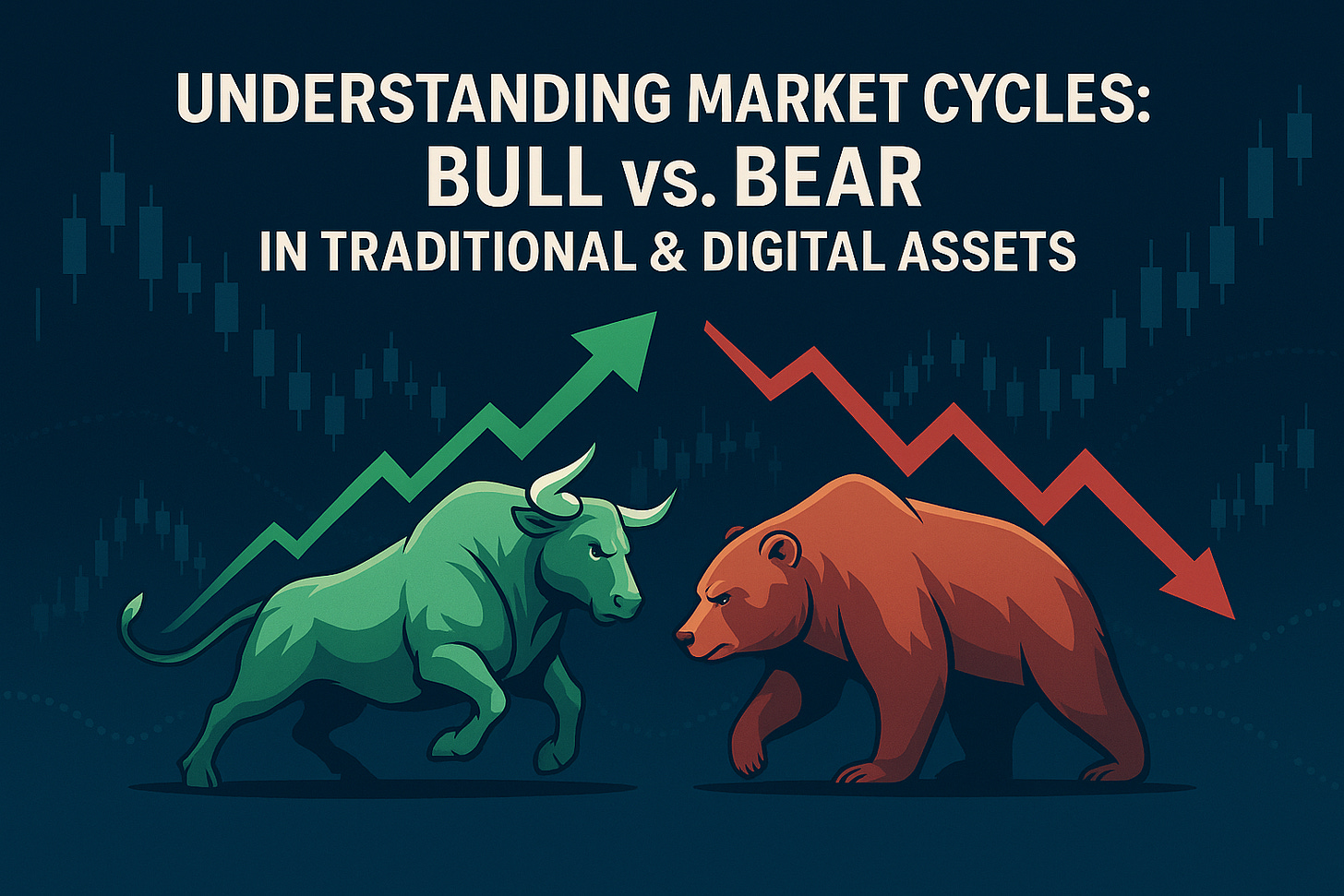Unlocking Market Cycles: Bull vs. Bear Dynamics in Traditional Finance and Crypto - Your Practical Guide
Get into the fascinating cycles of bull and bear markets across traditional and digital assets. Learn to spot trends, manage risk, and act strategically with real examples, stats, and actionable steps.
Are you trading in a rising tide or bracing for the downturn ahead?
Welcome! If you’ve ever wondered why markets rally with wild enthusiasm and then suddenly crash, you’re about to discover the patterns that underpin both traditional markets and the thrilling world of crypto. This blog post walks you through the anatomy of bull and bear cycles, shows how they unfold differently in stocks versus digital assets, and equips you with real-world examples, actionable advice, and a clear-eyed future outlook.
Table of Contents
Introduction
Understanding Market Cycles: Traditional vs. Crypto
Traditional Market Cycles
Crypto Market Cycles: Faster, Sharper, Leaner
Anatomy of a Crypto Cycle: Four Phases
Comparative Examples: Stock Market vs. Crypto
Actionable Strategies to Navigate Market Cycles
Key Takeaways
Future Outlook
Conclusion
Introduction
Markets move in waves. In traditional finance, those waves rise and fall over years. In crypto, they surge and implode in months. Why? Regulation, 24/7 trading, emotion-driven swings, and sharp macro shifts. If you learn to read these cycles, you won’t just follow the herd, you’ll act with purpose.
Understanding Market Cycles: Traditional vs. Crypto
Traditional Market Cycles
Historically, bull markets in equities last roughly 8.5 years, delivering cumulative returns of around 458% .
Bear phases are typically shorter averaging around 1 to 1.3 years .
Crypto Market Cycles
Entire cycles, bull and bear combined can unfold within 2–3 years, often aligned with Bitcoin’s halving every four years .
Crypto cycles are shaped by macro forces like interest rates and liquidity, not just internal triggers .
Anatomy of a Crypto Cycle: Four Phases
Accumulation
Market bottoms; smart money quietly buys. Volume is subdued.
Markup (Bull Run)
Prices climb fast, driven by adoption, media buzz, and optimism .
Distribution
Early holders take profits. Volatility spikes while prices range.
Crash (Bear Market)
Sharp decline often 70–80%+, lasting around a year .
Real-world stats:
Since 2013, after a 70%+ drop, Bitcoin has rallied an average of 3,485%, median 1,692% .
Cycles of 70% declines occur every ~2.1 years on average .
Comparative Examples: Stock Market vs. Crypto
Stock Markets:
Example: India’s BSE Sensex rose over 600% in five years from 2003-2008 .
Crypto Markets:
Bitcoin fell 78% from its 2021 high ($69K) to 2022 low ($15K), then rallied over 700% through 2025 .
Analysts now predict Bitcoin could exceed $200K or even $225K in 2025, fueled by institutional adoption, ETFs, and regulatory tailwinds .
Actionable Strategies to Navigate Market Cycles
Opponent-Agnostic Approach:
In bull times: Invest methodically, avoid chasing FOMO.
In bear phases: Preserve capital, consider dollar-cost averaging (DCA) .
Emotional Awareness:
Use sentiment tools like the Fear & Greed Index to stay grounded .
Macro & On-Chain Signals:
Monitor Bitcoin halving events, exchange reserves, and correlation with indices (e.g. S&P 500) .
Diversify Smartly:
Combine traditional assets with crypto not to jump in full throttle but build resilience.
Secure Foundations:
Use secure wallets (“not your keys, not your coins”) and stay informed on regulatory shifts and adoption trends .
Step-by-Step Real Case: DCA Through a Bear Turn
Identify a prolonged downtrend (e.g., 50–70% dip).
Allocate fixed monthly buys into crypto, regardless of price.
Track fear indicators to adjust allocations higher or lower.
When the cycle turns (e.g., halving triggers or macro easing), adjust to hold longer or diversify.
Key Takeaways
Benefits:
Capture outsized returns by entering cycles early
Apply disciplined strategies like DCA to manage volatility.
Risks:
Emotional buy-ins at market tops can lead to heavy losses.
Crypto’s high volatility requires strong risk controls.
Real-world Applications:
Public firms like MicroStrategy and ETFs are adopting crypto as a strategic asset .
Consumer intent: 14% of non-owners plan to enter crypto in 2025; another 48% remain open .
Future Outlook
Macro Catalysts Ahead:
Next Bitcoin halving is in 2028 historically followed by bull runs within 12–18 months .
Institutional Growth:
Asset managers like BlackRock and Fidelity continue to drive legitimacy and volume.
Innovation & Regulation:
Scalability improvements and clearer regulations globally may boost adoption.
Bull Market Potential:
Analyst projections suggest possible Bitcoin price surging above $200K, maybe to $225K in 2025 .
Conclusion
By understanding the familiar rhythm of bull and bear cycles both in traditional finance and the explosive, faster-moving crypto market you gain a powerful edge. Whether you’re accumulating quietly during bear phases, profit-taking in bull runs, or planning for the next halving-driven surge, strategic awareness sets successful investors apart.
Your Next Step:
Stay informed. Set milestone-based strategies. Monitor macro signals and crypto sentiment. And always secure your assets. Want help crafting your own cycle-navigation plan? Just let me know.
Subscribe to our newsletter for expert analysis and join our WhatsApp channel to continue the conversation. For daily updates, follow us on all socials; Instagram, Twitter, Telegram, and TikTok.
This article is for educational purposes only and should not be considered financial advice. Always conduct your own research (DYOR) before making any investment decisions.


